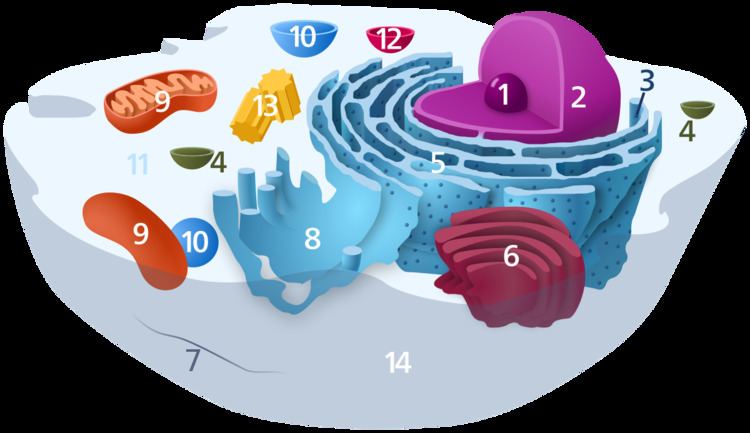Latin organella TH H1.00.01.0.00009 | FMA 63832 | |
 | ||
Similar Cell biology , Microscopy , Eukaryote | ||
In cell biology, an organelle (/ɔːrɡəˈnɛl/) is a specialized subunit within a cell that has a specific function. Individual organelles are usually separately enclosed within their own lipid bilayers.
Contents
- History and terminology
- Types of organelles
- Eukaryotic organelles
- Prokaryotic organelles
- Proteins and organelles
- References
The name organelle comes from the idea that these structures are to cells what an organ is to the body (hence the name organelle, the suffix -elle being a diminutive). Organelles are identified by microscopy, and can also be purified by cell fractionation. There are many types of organelles, particularly in eukaryotic cells. While Prokaryotes do not possess organelles per se, some do contain protein-based bacterial microcompartments, which are thought to act as primitive organelles.
History and terminology
In biology organs are defined as confined functional units within an organism. The analogy of bodily organs to microscopic cellular substructures is obvious, as from even early works, authors of respective textbooks rarely elaborate on the distinction between the two.
Credited as the first to use a diminutive of organ (i.e., little organ) for cellular structures was German zoologist Karl August Möbius (1884), who used the term organula (plural of organulum, the diminutive of Latin organum). In a footnote, which was published as a correction in the next issue of the journal, he justified his suggestion to call organs of unicellular organisms "organella" since they are only differently formed parts of one Cell, in contrast to multicellular organs of multicellular organisms.
Types of organelles
While most cell biologists consider the term organelle to be synonymous with "cell compartment", other cell biologists choose to limit the term organelle to include only those that are DNA-containing, having originated from formerly autonomous microscopic organisms acquired via endosymbiosis.
Under this definition, there would only be two broad classes of organelles (i.e. those that contain their own DNA, and have originated from endosymbiotic bacteria):
Other organelles are also suggested to have endosymbiotic origins, but do not contain their own DNA (notably the flagellum – see evolution of flagella).
Under the more restricted definition of membrane-bound structures, some parts of the cell do not qualify as organelles. Nevertheless, the use of organelle to refer to non-membrane bound structures such as ribosomes is common. This has led some texts to delineate between membrane-bound and non-membrane bound organelles. The non-membrane bound organelles, also called large biomolecular complexes, are large assemblies of macromolecules that carry out particular and specialized functions, but they lack membrane boundaries. Such cell structures include:
Eukaryotic organelles
Eukaryotic cells are structurally complex, and by definition are organized, in part, by interior compartments that are themselves enclosed by lipid membranes that resemble the outermost cell membrane. The larger organelles, such as the nucleus and vacuoles, are easily visible with the light microscope. They were among the first biological discoveries made after the invention of the microscope.
Not all eukaryotic cells have each of the organelles listed below. Exceptional organisms have cells that do not include some organelles that might otherwise be considered universal to eukaryotes (such as mitochondria). There are also occasional exceptions to the number of membranes surrounding organelles, listed in the tables below (e.g., some that are listed as double-membrane are sometimes found with single or triple membranes). In addition, the number of individual organelles of each type found in a given cell varies depending upon the function of that cell.
Mitochondria and chloroplasts, which have double-membranes and their own DNA, are believed to have originated from incompletely consumed or invading prokaryotic organisms, which were adopted as a part of the invaded cell. This idea is supported in the Endosymbiotic theory.
Other related structures:
Prokaryotic organelles
Prokaryotes are not as structurally complex as eukaryotes, and were once thought not to have any internal structures enclosed by lipid membranes. In the past, they were often viewed as having little internal organization, but slowly, details are emerging about prokaryotic internal structures. An early false turn was the idea developed in the 1970s that bacteria might contain membrane folds termed mesosomes, but these were later shown to be artifacts produced by the chemicals used to prepare the cells for electron microscopy.
However, more recent research has revealed that at least some prokaryotes have microcompartments such as carboxysomes. These subcellular compartments are 100–200 nm in diameter and are enclosed by a shell of proteins. Even more striking is the description of membrane-bound magnetosomes in bacteria, reported in 2006, as well as the Nucleus-like structures of the Planctomycetes that are surrounded by lipid membranes, reported in 2005.
Proteins and organelles
The function of a protein is closely correlated with the organelle in which it resides. Some methods were proposed for predicting the organelle in which an uncharacterized protein is located according to its amino acid composition and some methods were based on pseudo amino acid composition.
